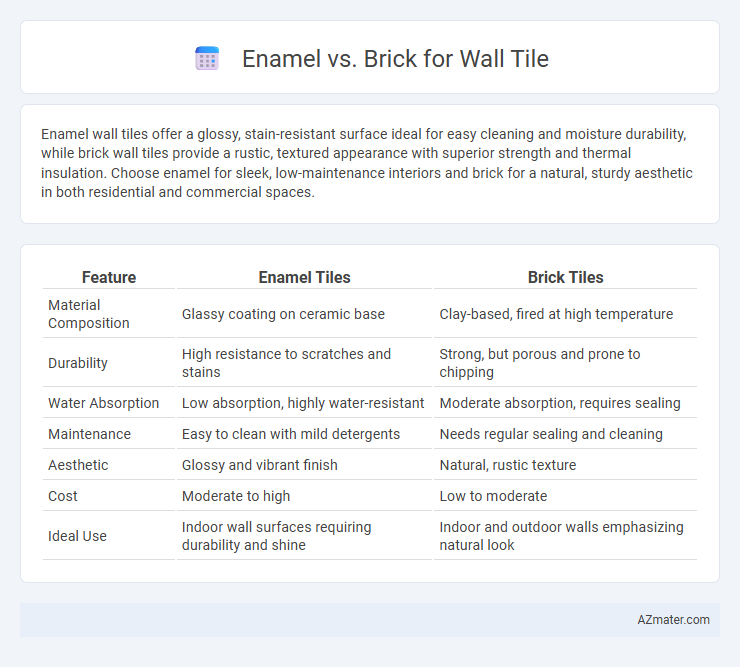Enamel wall tiles offer a glossy, stain-resistant surface ideal for easy cleaning and moisture durability, while brick wall tiles provide a rustic, textured appearance with superior strength and thermal insulation. Choose enamel for sleek, low-maintenance interiors and brick for a natural, sturdy aesthetic in both residential and commercial spaces.
Table of Comparison
| Feature | Enamel Tiles | Brick Tiles |
|---|---|---|
| Material Composition | Glassy coating on ceramic base | Clay-based, fired at high temperature |
| Durability | High resistance to scratches and stains | Strong, but porous and prone to chipping |
| Water Absorption | Low absorption, highly water-resistant | Moderate absorption, requires sealing |
| Maintenance | Easy to clean with mild detergents | Needs regular sealing and cleaning |
| Aesthetic | Glossy and vibrant finish | Natural, rustic texture |
| Cost | Moderate to high | Low to moderate |
| Ideal Use | Indoor wall surfaces requiring durability and shine | Indoor and outdoor walls emphasizing natural look |
Introduction: Enamel vs Brick in Wall Tile Applications
Enamel wall tiles offer a glossy, smooth finish that enhances durability and stain resistance, making them ideal for high-moisture areas like kitchens and bathrooms. Brick tiles provide a rustic and textured aesthetic, known for their strength and natural thermal insulating properties, suitable for accent walls and exterior facades. Choosing between enamel and brick depends on the desired visual appeal, maintenance requirements, and the environmental conditions of the installation site.
Material Composition and Properties
Enamel wall tiles consist of a glassy, vitreous coating fused to a base ceramic or metal, offering a smooth, glossy surface with high resistance to stains and moisture. Brick tiles are composed primarily of natural clay fired at high temperatures, providing a porous, textured surface known for durability and thermal insulation. Enamel tiles excel in hygiene and ease of cleaning, while brick tiles offer greater structural strength and a rustic aesthetic.
Aesthetic Appeal and Design Options
Enamel wall tiles offer a sleek, glossy finish with vibrant color options that enhance modern and minimalist aesthetics, while brick wall tiles provide a textured, rustic look perfect for industrial or farmhouse styles. Enamel tiles allow for intricate patterns and a wide range of hues, making them versatile for creative design schemes, whereas brick tiles emphasize natural earth tones and a timeless, rugged appearance. Choosing between enamel and brick wall tiles depends on the desired ambiance, with enamel focusing on contemporary elegance and brick embracing historical charm.
Durability and Longevity
Enamel tiles offer a durable, glossy surface resistant to stains and moisture, making them suitable for indoor areas with moderate wear. Brick tiles provide exceptional longevity and robustness, especially in high-traffic or outdoor environments, due to their dense, hard-fired composition. While enamel tiles resist surface scratches, brick tiles withstand impact and weathering better, ensuring extended durability in various applications.
Maintenance and Cleaning Requirements
Enamel wall tiles offer a smooth, non-porous surface that resists stains and requires minimal effort for routine cleaning, typically needing only a soft cloth and mild detergent. Brick tiles, while durable and visually appealing, are porous and can absorb dirt and moisture, necessitating regular sealing and more intensive cleaning to prevent mold and staining. Maintenance of enamel tiles is generally lower, whereas brick tiles demand consistent upkeep to maintain their appearance and structural integrity.
Installation Process and Complexity
Enamel wall tiles offer a smoother surface and generally require adhesive application, making their installation quicker and less labor-intensive compared to brick tiles, which demand precise alignment and often mortar setting for proper stability. Brick tiles involve a more complex installation process due to their uneven texture and weight, necessitating additional preparation like wall reinforcement and careful grouting to ensure durability. The simpler installation of enamel tiles reduces labor costs and time, while brick tiles provide a more robust and rustic finish, albeit with increased installation complexity.
Cost Comparison and Budget Considerations
Enamel wall tiles generally offer a more cost-effective option compared to brick tiles, with prices ranging from $5 to $15 per square foot, making them suitable for budget-conscious projects. Brick tiles tend to be more expensive, often costing between $10 and $25 per square foot due to their durability and distinctive aesthetic appeal. When budgeting, consider installation costs as enamel tiles are typically easier and quicker to install, reducing labor expenses, whereas brick tiles may require specialized labor and additional preparation, impacting overall project costs.
Environmental Impact and Sustainability
Enamel wall tiles offer a lower environmental impact due to their long lifespan and recyclability, reducing waste in construction projects. Brick tiles, sourced from natural clay, provide excellent sustainability as they are biodegradable and require less energy-intensive manufacturing processes. Choosing enamel or brick tiles depends on balancing durability with eco-friendly production and end-of-life disposal considerations.
Ideal Locations and Use Cases
Enamel wall tiles are ideal for high-moisture environments like bathrooms and kitchens due to their water resistance and ease of cleaning. Brick tiles suit rustic or industrial interior designs, perfect for accent walls and fireplaces where durability and aesthetic texture matter. Both materials offer distinct advantages, with enamel providing a sleek, smooth finish and brick tiles contributing warmth and character to living spaces.
Conclusion: Choosing Between Enamel and Brick Wall Tiles
Enamel wall tiles offer a sleek, glossy finish with enhanced stain resistance, making them ideal for modern, easy-to-clean surfaces; brick tiles provide a rustic, textured appearance that adds warmth and character, suitable for more traditional or industrial designs. The choice depends on whether durability, maintenance, and a polished aesthetic are prioritized (enamel) or if natural texture and a robust, earthy look are desired (brick). Considering factors like installation environment, decor style, and long-term upkeep ensures selecting the best wall tile material for specific needs.

Infographic: Enamel vs Brick for Wall Tile
 azmater.com
azmater.com